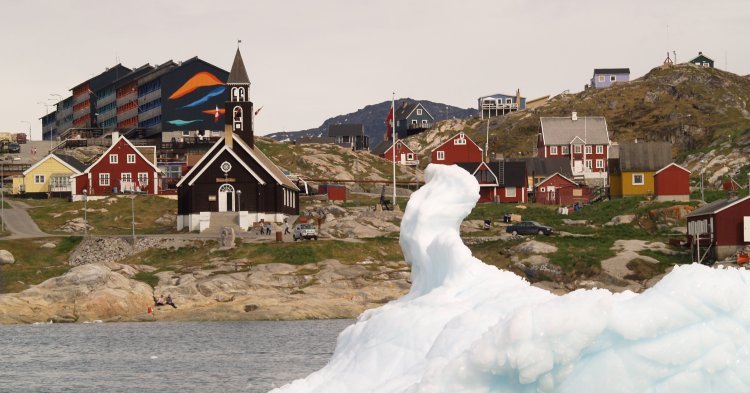Greenland and Iceland share similar unique historical and geographical characteristics. Both countries were inhabited by Norwegian Viking explorers fleeing political persecution, and are considered to be part of Europe in terms of culture, but belong geographically speaking to the American continent, and both foster distinctive identities. For centuries, they have been so well-isolated from the rest of the world that the Icelandic government has implemented a policy against incest to prevent people from the same family from reproducing without even knowing. Over the last fifty years, Greenland and Iceland have made a dramatic entry onto the world scene. Being at the heart of major territorial issues, Greenland is caught between American, Chinese, and European Arctic ambitions. Once simply a Danish colony, the country is increasingly attracting interest. Since the 1970s, this has led Greenland to make strong political decisions in order to fight for independence.
The Arctic gives wings
The 1970s marked the beginning of a double realisation: global warming, together with the discovery of significant oil, gas, and mining resources in the Arctic. Greenland suddenly found itself at the centre of major international issues while emerging from its historical isolation. Attempts by the United States to buy Greenland are evidence of the country’s entrance onto the world stage. At the end of World War II, amidst a climate of Cold War tensions, the US, led by Harry S. Truman offered $100 million to Denmark to turn Greenland American. In August 2019, US president Donald Trump made Denmark a new offer. The media ridiculed this suggestion and saw it as a yet more proof of the president’s folly. However, informed observers have noticed the familiar pattern of American foreign policy in the Arctic, as well as interpreting it as a logical reaction to Russian hegemony and the rise of Chinese power in the region. Moreover, in the increasingly mad race for oil and access to strategic routes to the Far North, Greenland is in a prime position. There are many reasons to be interested in Greenland. Not only is it the largest island-continent in the world, bordering Iceland and Canada, 80% of its territory is located above the Arctic Circle, the starting point for many scientific expeditions. In the south of the island, a large amount of oil and rare metals can be found. The United States have historically regarded Greenland as an essential link for its national security, a view inherited from the Monroe doctrine. During the Second World War, the Americans prevented Greenland from being occupied by the Nazis following Danish defeat. Built in 1941, the US base in Thule (now called Qaanaaq) was arguably the most strategic base of the Cold War, home to US nuclear missiles. The United States have always regarded with contempt what they consider ‘Little Denmark’s arrogant occupation of a strategic territory for America’.
From ‘Danisation’ to ‘Greenlandisation’ of the island
The strategic importance of Greenland and the tensions between the US and Denmark over the sovereignty of the ‘green land’ have led to an awareness of identity among Greenlanders. Starting in the 1970s, the result was the beginning of a long journey towards what should turn out to be, in a few years’ time, the country’s independence. In 1979, Greenland became an autonomous territory, after losing its status as a colony in 1953. Since then, it has gained more and more freedoms from the Danish crown.
After becoming autonomous, Denmark wanted to stabilise the situation by accelerating its wide-reaching ‘Danisation’ policy of the island. This strategy included regrouping housing into urban centres, modernising infrastructures, introducing Danish workers and private Danish companies, greater access to education, more teaching in Danish… the goal is to make Greenlanders more Danish by putting an end to the island’s different identity. This is a policy of cultural integration, which represents a necessarily Danish modernity. The policy is very symbolically violent and will anchor in Greenlandic minds the idea that the Danish, and by extension Europeans, only offer negative contributions. This is all the more true as there are many inequalities in treatment: the Danes have access to free, fully-equipped housing, while the Greenlanders heat with coal, fetch their water from a cistern, and use paraffin lamps. Danish salaries are also much higher than those of Greenlanders. Danes and Greenlanders do not mix much, and intimate relationships between them are forbidden, even though they exist unofficially. At the same time, a ‘Greenlandisation’ is also taking place, as the ‘Other’ is becoming aware of their ‘Otherness’ and further develops their own identity.
First Europe, then Denmark: towards inevitable independence?
It was in this context of accelerated ‘Danisation’ and rising ‘Greenlandisation’ that the question of the island’s relationship with Europe arose. No longer a Danish colony or province, autonomous Greenland was free to consider whether or not it wanted to participate in a far, far away European structure. In 1972, Denmark showed its disagreement by joining the European Economic Community (EEC). At the same time, ‘Inuit Ataqatigiit’ (Inuit Community), a Greenlandic separatist party, was founded. In 1977, the Inuit Circumpolar Council (ICC) was founded, bringing together the Inuit peoples of the Arctic in a single organisation. Greenland’s independence aspirations were streamlined, both in relation to Denmark and Europe - the two being closely linked in the minds of Greenland’s Inuit peoples. In 1979, Greenland’s internal autonomy was definitively enshrined in the Danish constitution following a referendum.
A new problem soon arose for the Greenlandic authorities. Denmark’s entry into the EEC made Greenlanders fear increased competition in the fishing sector. Arctic waters were rich in fish and 95% of the island’s exports depended on fishing, meaning that Greenland’s involvement in the EEC quickly became unpopular. In the referendum on Denmark’s accession to the EEC, Greenlanders had already voted 70.3% against membership, while the Danes as a whole had approved with 63.3% of the votes cast. In 1982, a referendum on Greenland’s exit from the EEC was held and 52% of voters were in favour of withdrawal. In 1985, following exit negotiations, Greenland withdrew from the EEC, the European Coal and Steel Community, and the Euratom agreements. In 1985 and 1992 respectively, the island also became a ‘constituent country’ of Denmark and an OCT (Overseas Country and Territory) of the EEC and then the EU, in the same way as French Polynesia or the Dutch Antilles, for example.
What relationship does Greenland have with the European Union today?
When Greenland inevitably becomes independent, it will leave the EU completely and probably won’t negotiate a special status. It is more interested in establishing a relationship with the United States rather than the ‘old Europe’ colonisers. Today, Greenland is not a member of the EU or Schengen, just as Denmark’s currency is not the euro but the Danish krone. However, the inhabitants have European citizenship by virtue of their Danish citizenship. Though European law is not imposed on them, they should be able to vote in European elections, but this is hardly possibility. The Court of Justice of the EU recently ruled against the Netherlands for not holding European elections in Aruba (an island in the West Indies with OCT status). A decision like that could set a precedent and guarantee a genuine European voting right for Greenlanders. Greenland also receives development aid from the European Central Bank. Greenland does not participate in the common market, except for a few agreements regarding fishing.
In 2008, Denmark passed a new law allowing Greenland to become independent by referendum. Since 2016, the ‘country’ has had a ministry for independence. The country’s budget, which is half dependent on Danish and European funding, needs to become more autonomous. With this in mind, Greenland chose to focus on mining, oil extraction and industrial fishing, all in partnership with the United States and China. The latter views independence very favourably because it means a major loss of influence for Europe in the Arctic. If Greenland does not manage to become independent by leaving Europe and then Denmark, it could look at establishing a relation with the United States. This could be good news for the US, which has been interested in Greenland since 1867! But beware, for China is watching…


Follow the comments: |
|
